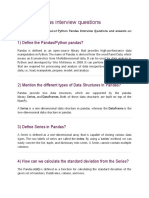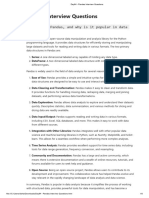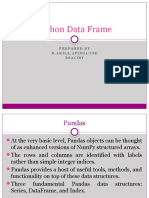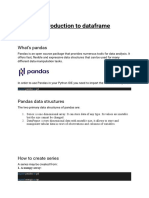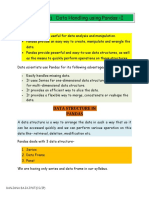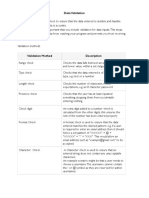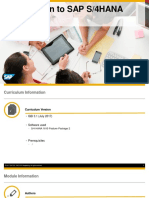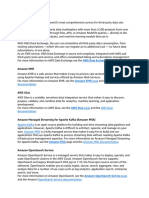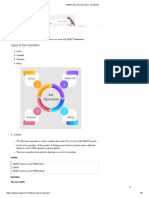Pandas
Installation
�Installation
�What kind of data does pandas handle?
• Pandas is a powerful open-source data manipulation and analysis
library for Python.
• It is built on top of the NumPy library and provides data structures
such as Series and DataFrame that are designed to handle various
types of data.
�The primary data structures in pandas:
• Series: A one-dimensional labeled array that can hold any data type. It
is similar to a column in a spreadsheet or a single column in a SQL
table.
• DataFrame: A two-dimensional labeled data structure with columns
that can be of different data types. It can be thought of as a table or a
spreadsheet, where each column is a Series.
�Pandas can handle various types of data,
including:
• Numeric Data: Integer and floating-point numbers.
• Text Data: String data and text.
• Time Series Data: Pandas provides robust support for time-based data
and includes various functions for time series analysis.
• Categorical Data: Data with a fixed, limited set of values.
• Missing Data: Pandas provides methods for handling missing data,
making it easy to clean and preprocess datasets.
• Mixed Data Types: Pandas DataFrames can handle columns with
different data types.
�Pandas can handle various types of data,
including: Cont…
• Pandas is widely used in data analysis, cleaning, transformation, and
exploration tasks, making it a valuable tool in the field of data science.
It is commonly used in conjunction with other libraries such as
NumPy, Matplotlib, and scikit-learn for comprehensive data analysis
and machine learning workflows.
�What kind of
data does
pandas handle?
• When working with
tabular data, such as data
stored in spreadsheets or
databases, pandas is the
right tool for you.
• pandas will help you to
explore, clean, and
process your data.
• In pandas, a data table is
called a DataFrame.
�How do I read and write tabular data?
• In pandas, reading and writing tabular data is commonly done using
the read_* and to_* functions, where * can be replaced with various
file formats.
�Reading Tabular Data: CSV
�Reading Tabular Data: Excel
�Reading Tabular Data: JSON
�Reading Tabular Data: SQL Database
�How do I read and write tabular data?
• pandas supports the integration with many file formats or data
sources out of the box (csv, excel, sql, json, parquet,…).
• Importing data from each of these data sources is provided by
function with the prefix read_*.
• Similarly, the to_* methods are used to store data.
�How do I select a subset of a table?
• Selecting or filtering specific rows and/or columns? Filtering the data
on a condition?
• Methods for slicing, selecting, and extracting the data you need are
available in pandas.
�How do I select a subset of a table? Cont…
• In pandas, you can select a subset of a DataFrame using various
methods. Here are some common techniques:
� 1. Selecting Columns:
To select one or more columns, you can use square brackets or the loc and iloc methods:
� 2. Selecting Rows:
To select rows based on conditions, you can use boolean indexing:
�3. Selecting both Rows and Columns:
You can combine row and column selections using loc or iloc:
�4. Selecting by Position:
You can use the iloc method to select rows and columns by their integer positions:
�5. Using isin for Filtering:
You can use the isin method to filter rows based on a list of values:
�6. Using query Method:
The query method allows you to write SQL-like queries to filter data:
�How to create plots in pandas?
• pandas provides plotting your data out of the box, using the power of
Matplotlib.
• You can pick the plot type (scatter, bar, boxplot,…) corresponding to
your data.
�How to create plots in pandas? Cont…
• Pandas integrates with the Matplotlib library to provide convenient
functions for creating various types of plots directly from DataFrames.
�1. Line Plot:
�2. Bar Plot:
�3. Histogram:
�4. Scatter Plot:
�5. Box Plot:
�6. Area Plot:
�7. Pie Chart:
�8. Kernel Density Estimate (KDE) Plot:
�Multiple Plots:
You can create multiple plots in a
single figure using subplots:
�Multiple Plots:
�How to create new columns derived from
existing columns?
• There is no need to loop over all rows of your data table to do
calculations. Data manipulations on a column work elementwise.
• Adding a column to a DataFrame based on existing data in other
columns is straightforward.
�How to calculate summary statistics?
• Basic statistics (mean, median, min, max, counts…) are easily
calculable.
• These or custom aggregations can be applied on the entire data set, a
sliding window of the data, or grouped by categories. The latter is also
known as the split-apply-combine approach.
�How to reshape the layout of tables?
• Change the structure of your data table in multiple ways.
• You can melt() your data table from wide to long/tidy form or pivot()
from long to wide format. With aggregations built-in, a pivot table is
created with a single command.
�How to combine data from multiple tables?
• Multiple tables can be concatenated both column wise and row wise
as database-like join/merge operations are provided to combine
multiple tables of data.
�How to handle time series data?
• pandas has great support for time series and has an extensive set of
tools for working with dates, times, and time-indexed data.
�How to manipulate textual data?
• Data sets do not only contain numerical data. pandas provides a wide
range of functions to clean textual data and extract useful information
from it.











